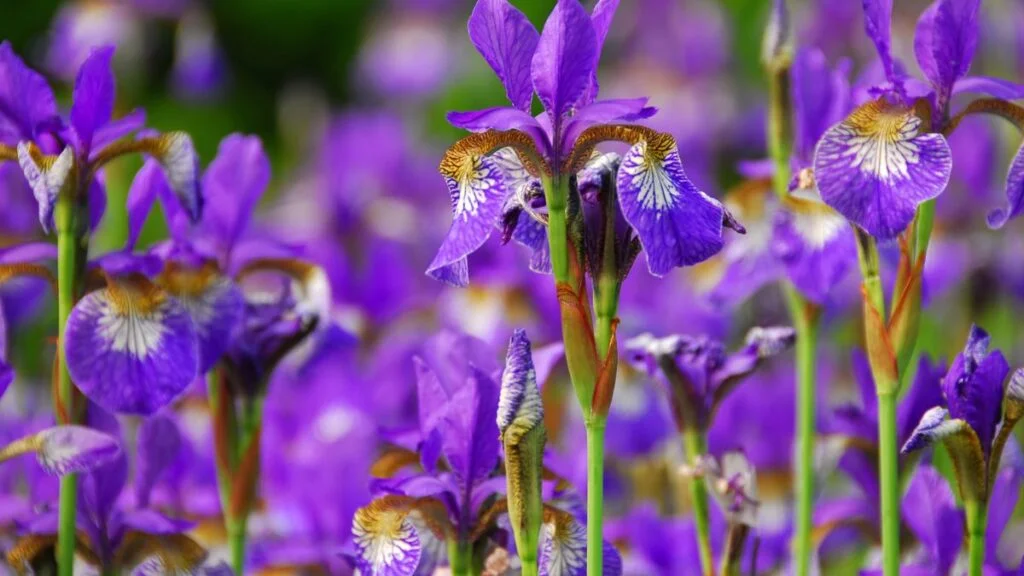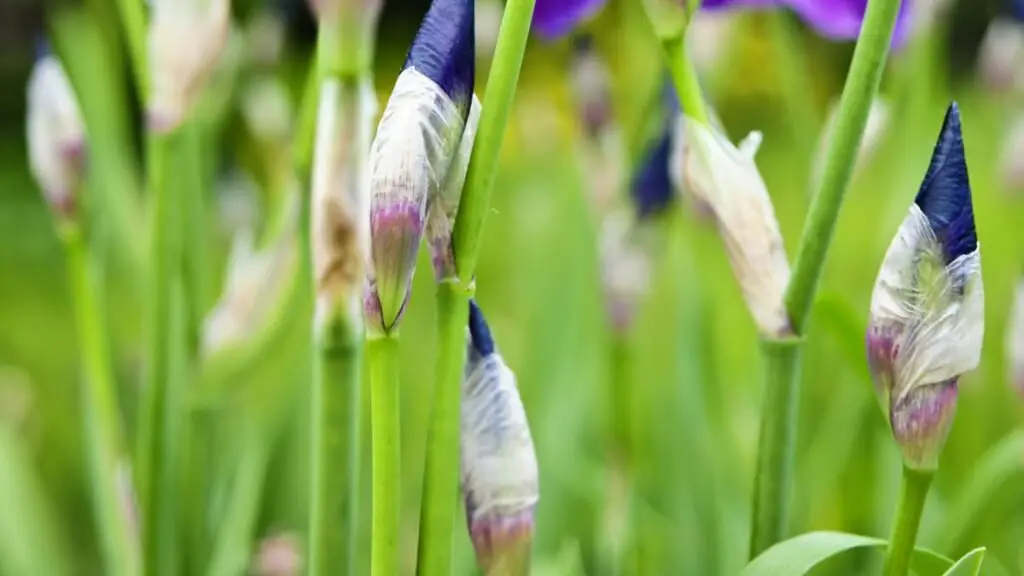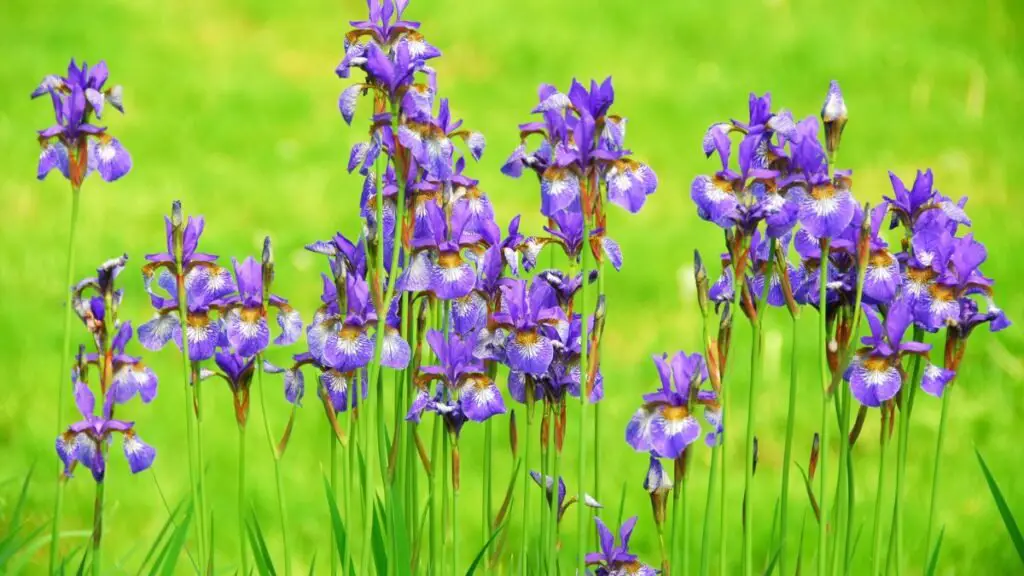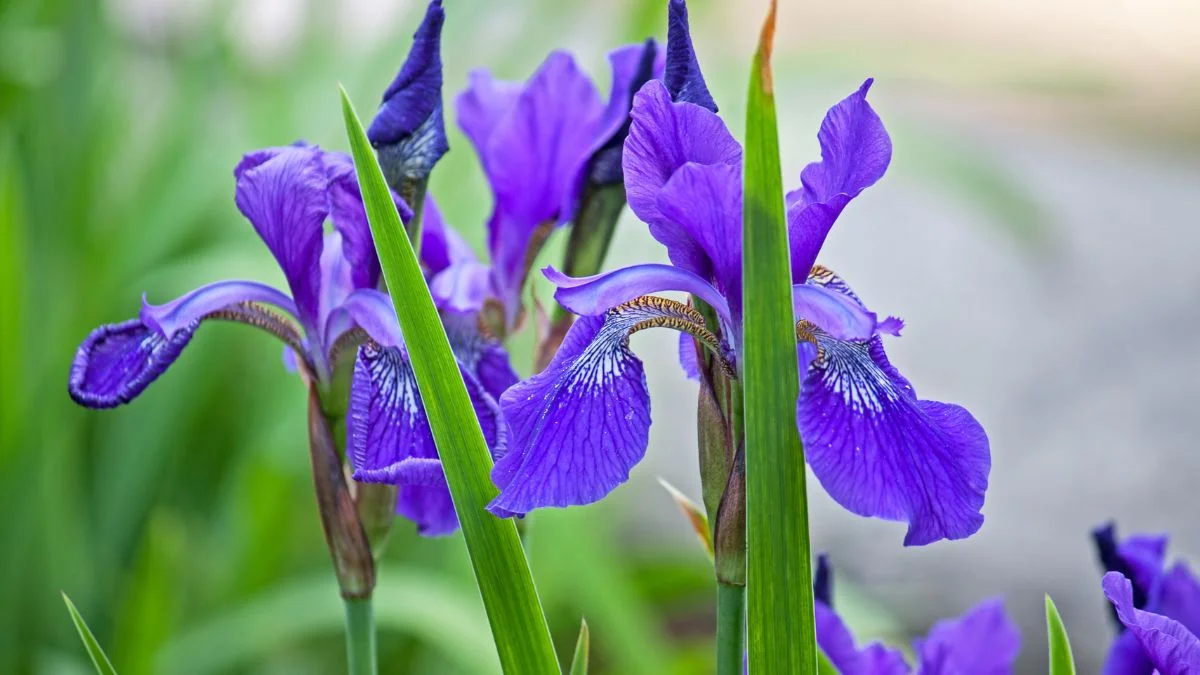Looking for the perfect irises companion plants? You've come to the right place! Whether you're a seasoned gardener or just starting out, selecting the right companions for your irises can make all the difference in creating a thriving garden. With a wide range of options available, from classic pairings to unique combinations, there's something to suit every taste and style.
When it comes to choosing companion plants for irises, consider factors such as color, height, and blooming times. Popular choices include daylilies, peonies, and salvia, which complement irises beautifully with their contrasting colors and textures. Additionally, planting low-growing ground covers like creeping phlox or lamb's ear around the base of your irises can help suppress weeds and retain moisture in the soil.
For a visually striking display, try creating a layered effect by combining irises with tall spiky plants like foxgloves or delphiniums in the background, and shorter flowering perennials like catmint or coreopsis in the foreground. Experimenting with different combinations will not only enhance the aesthetic appeal of your garden but also promote biodiversity and attract beneficial insects.
Ready to take your iris garden to the next level? Stay tuned for more expert tips and creative ideas on how to maximize the beauty and productivity of your garden space. Whether you're interested in learning about soil preparation, pest management, or designing stunning flower arrangements, there's always more to discover when it comes to gardening with irises and their companions.
Key Takeaways
- Understand the Benefits: Companion planting with irises can enhance garden beauty, repel pests, and improve soil health.
- Choose Wisely: Select companion plants based on their compatibility with irises, considering factors like sunlight and soil preferences.
- Plan Thoughtfully: Strategically plan your garden layout to optimize the benefits of companion planting and create a harmonious environment for your irises.
- Diversify Companions: Experiment with a variety of companion plants such as yarrows, daylilies, and catmints to complement your bearded irises.
- Tackle Challenges: Address planting problems like overcrowding or competition for resources by spacing plants appropriately and providing adequate care.
- Prolong Blooming: Extend the flowering season by selecting companion plants that bloom at different times, ensuring a continuous display of colors in your garden.
Understanding Companion Planting
Concept Basics
Companion plants in gardening are plants that benefit each other when grown in close proximity. For irises, companion plants play a crucial role by enhancing the overall health and growth of the irises. Selecting suitable companion plants is essential to ensure mutual benefits and avoid any negative interactions.
Benefits for Irises
Companion plants can significantly enhance the aesthetic appeal of irises by providing contrasting colors and textures, creating a visually appealing garden. These plants also attract beneficial insects like pollinators and pest predators, contributing to a healthier ecosystem around the irises. Companion plants can improve soil health by adding nutrients and enhancing soil structure through their root systems.
Common Concerns
One common concern with companion planting for irises is the potential competition for resources such as water, sunlight, and nutrients between the irises and their companions. To prevent overcrowding, it's important to carefully plan the layout and spacing when planting companion plants alongside irises. In case of pests or diseases affecting both the irises and their companions, it's crucial to promptly identify the issue and implement appropriate pest management strategies to protect the overall garden health.
Characteristics of Good Companions

Contrast and Impact
When pairing irises with companion plants, contrasting colors can create visual interest in the garden. The vibrant hues of irises against the backdrop of muted tones from other plants can make each plant stand out. Contrasting textures between irises' sword-like leaves and fluffy foliage of companions can add depth to the overall garden design.
Mixing different foliage textures is crucial for a dynamic garden. Combining smooth, glossy leaves of irises with rough or fuzzy textures of other plants creates an intriguing visual contrast. This variation not only adds interest but also enhances the overall aesthetic appeal of the garden.
Achieving a harmonious balance between irises and their companions involves careful selection based on height, color, and texture. By choosing plants that complement rather than overpower irises, you can create a cohesive look in your garden. Consider plants with similar care requirements to ensure they thrive together.
Texture Variations
Incorporating various foliage textures in your garden design is essential for creating visual interest. Mixing bold, broad leaves of irises with delicate fern-like foliage of companions adds complexity to the landscape. This diversity in textures helps prevent monotony and keeps the garden visually engaging.
Different textures play a vital role in adding depth to your garden's appearance. Pairing the smooth petals of irises with spiky or velvety leaves of other plants creates a multi-dimensional effect. These contrasting textures draw the eye and make the garden more visually appealing.
Examples of companion plants with unique textures that complement irises include Lamb's Ear with its soft, fuzzy leaves juxtaposed against the sleek iris foliage. The feathery fronds of Astilbe provide an elegant contrast to the structured form of irises, enhancing the overall beauty of the planting scheme.
Height Differences
Considering height differences when selecting companion plants is key to achieving a balanced garden design. Taller plants positioned behind irises act as a backdrop, highlighting their beauty while providing structural support. Meanwhile, shorter plants placed in front create a foreground that frames and accentuates the irises.
Creating a visually appealing layered effect in your garden involves strategic placement of plants at varying heights. By arranging taller companions towards the back and gradually transitioning to shorter ones at the front, you can achieve a sense of depth and dimension in your planting beds.
To create an aesthetically pleasing composition, intersperse medium-height perennials like Salvia or Catmint among your irises to bridge the gap between tall and short plants seamlessly.
Planning Your Garden

Border Design
When planning your garden, incorporate companion plants strategically to create well-defined borders around irises. This not only adds visual interest but also enhances the overall structure of the garden. Select companion plants carefully to ensure they complement the irises and create a harmonious border design.
- Choose plants with varying heights, textures, and colors to create a visually appealing border.
- Consider incorporating perennials like daylilies or peonies that bloom at different times to extend the flowering season.
- Avoid planting aggressive species that may outcompete or overshadow the irises in the border.
Dedicated Beds
Dedicated beds for irises and their companion plants offer numerous benefits. By creating separate beds for specific plant varieties, you can streamline maintenance tasks and care routines. This approach allows you to focus on the unique needs of each plant type.
- Dedicated beds help prevent overcrowding and competition for resources among different plant species.
- They provide a designated space for each type of plant, making it easier to monitor growth and address any issues promptly.
- Consider grouping plants with similar water and sunlight requirements together in dedicated beds to optimize growing conditions.
Best Companion Plants
Oriental Poppies
Oriental Poppies complement irises with their vibrant hues and unique petal textures, adding a dynamic contrast to the garden. Their bold reds, oranges, and pinks create a stunning visual impact alongside the delicate iris blooms. When planting Oriental Poppies with irises, ensure they receive ample sunlight and well-drained soil to thrive harmoniously.
Integrating Oriental Poppies with irises not only enhances the overall aesthetics but also attracts beneficial pollinators like bees and butterflies to the garden. Consider planting them in clusters near your irises to create a striking focal point amidst the greenery.
Lupine
Lupines bring a vertical dimension to the garden when paired with irises, thanks to their tall flower spikes that rise above the iris foliage. The varied colors of Lupine flowers, ranging from blues and purples to pinks and whites, offer a captivating display against the backdrop of irises. To integrate Lupines effectively with irises, plant them in groups behind or between iris clumps for a visually appealing arrangement.
The combination of Lupines and irises not only adds visual interest but also encourages biodiversity by attracting pollinators like hummingbirds. Ensure adequate spacing between Lupines and irises to allow proper air circulation and prevent overcrowding.
Allium
Allium's globe-shaped flower heads provide an intriguing architectural element when planted alongside irises, creating a captivating visual contrast in the garden. These unique blooms come in various sizes and shades, offering versatility in pairing with different iris varieties. Selecting Allium varieties that bloom at different times can ensure continuous flowering throughout the season, enhancing the garden's overall appeal.
Incorporating Alliums with irises not only adds aesthetic value but also supports ecological balance by attracting bees and other pollinators essential for plant reproduction. Choose Allium bulbs that complement your iris color palette for a cohesive and visually pleasing garden design.
Delphinium
Delphinium's towering spires of flowers make an impressive statement next to the elegant blooms of irises, creating a dramatic visual impact in the garden landscape. Their range of colors, including blues, purples, pinks, and whites, offers versatility in pairing with various iris shades. Planting Delphiniums strategically among irises can establish focal points within the garden while adding vertical interest.
Pairing Delphiniums with irises requires attention to spacing and sunlight requirements to ensure both plants thrive optimally. Consider planting Delphiniums towards the back of iris beds to create depth and height variations in your garden design.
More Bearded Iris Companions

Baptisia
Baptisia comes in various colors like blue, white, and yellow, ideal for complementing different iris shades. Its unique characteristics include a deep root system that pairs well with irises, enhancing soil structure. When planting Baptisia, ensure proper spacing to allow both plants to thrive and create a visually appealing garden.
Peony
Peonies offer a classic appeal as companion plants for irises due to their large, showy blooms. Their fragrant flowers not only attract pollinators but also blend beautifully with the vibrant hues of irises. To create a harmonious planting scheme, plant peonies behind irises to provide a stunning backdrop and varying heights in the garden.
Daylilies
Daylilies are excellent companions for irises as they provide a long-lasting blooming period, extending the color display in the garden. With a wide range of colors available, from soft pastels to bold oranges and reds, daylilies offer versatility in pairing with different iris shades. To create a vibrant garden display, intersperse daylilies among irises for an eye-catching contrast.
Salvia
Salvias serve as beneficial companion plants for irises due to their vibrant blooms that add pops of color and texture to the garden landscape. Selecting Salvia varieties that bloom alongside irises ensures continuous flowering throughout the season. Integrating salvias strategically among iris beds can enhance the overall visual impact and attract beneficial insects to the garden.
Enhancing Garden Beauty
Visual Impact Strategies
Creating a visually appealing garden involves strategic placement of companion plants. Color schemes play a crucial role in enhancing the overall look. By selecting plants with complementary colors, you can create a harmonious and attractive display.
When planning your garden layout, consider the height and spread of each plant to ensure a balanced composition. Focal points can be created by placing vibrant or unique plants strategically throughout the garden. These focal points draw the eye and add interest to the landscape.
To maximize visual impact, vary the textures of companion plants. Combining plants with different leaf shapes and sizes adds depth and dimension to the garden. Mixing foliage with varying shades of green leaves creates a dynamic and visually engaging environment.
Texture and Color Schemes
Texture and color schemes are essential elements in garden design, especially when working with irises and their companion plants. Contrasting textures, such as pairing delicate ferns with sturdy irises, create an interesting visual contrast that highlights each plant's unique characteristics.
Harmonizing colors can also elevate the beauty of your garden. Pairing irises with plants that have similar hues but different tones can create a cohesive and soothing color palette. For example, combining purple irises with pale yellow coreopsis results in a visually pleasing combination that enhances both plants' colors.
Effective texture combinations include pairing spiky grasses with soft lamb's ear or glossy hostas with feathery astilbes. These combinations not only create visual interest but also promote biodiversity within your garden. By experimenting with different textures and colors, you can achieve a stunning and diverse landscape that showcases the beauty of your irises and their companions.
Addressing Planting Problems
Optimal Conditions
To ensure successful growth, both irises and their companion plants require specific conditions. Adequate sunlight is crucial for optimal growth, typically around six to eight hours daily. Soil quality is essential, with well-draining soil rich in organic matter being ideal. Proper watering is vital; irises prefer consistently moist soil, while some companion plants may have different requirements.
Maintaining optimal conditions involves regular monitoring of sunlight exposure. Ensure the soil is well-drained to prevent waterlogging, which can lead to root rot. Water the plants deeply but infrequently to encourage deep root growth and drought tolerance.
Dry Border Solutions
Selecting companion plants that thrive in dry border conditions is key when planting alongside irises. Opt for drought-tolerant plants like lavender, sedum, or yarrow to create a sustainable garden design. These plants not only reduce water usage but also add visual interest to your garden borders.
Creating visually appealing borders in dry conditions involves strategic plant selection. Consider using mulch to retain moisture and reduce watering frequency. Group plants with similar water needs together to simplify maintenance tasks.
Extending the Flowering Season
Early Bloomers
Complement your irises with early blooming companion plants like daffodils and tulips for a vibrant garden. These plants not only add color but also attract pollinators, enhancing the overall garden ecosystem. When choosing early bloomers, opt for varieties that contrast or harmonize with the hues of irises to create an aesthetically pleasing display.
Pairing irises with early bloomers ensures a continuous burst of colors from spring to early summer, transforming your garden into a visual delight. The combination of different bloom times creates a dynamic landscape that evolves throughout the season, keeping your outdoor space lively and engaging.
- Pros:
- Adds diversity to the garden's color palette
- Attracts beneficial insects and pollinators
- Creates an eye-catching visual display
- Cons:
- May require regular maintenance to manage different plant care needs
Late Bloomers
For an extended flowering season, consider planting late blooming companions such as asters and sedums alongside irises. These plants provide a stunning contrast to the earlier blooms, adding depth and richness to your garden design. Late bloomers not only enhance the aesthetic appeal but also contribute to the overall health of the garden by attracting beneficial wildlife.
The combination of irises with late bloomers offers a striking visual impact, creating a captivating scene that transitions from summer to fall seamlessly. Choose plants that thrive in the late season conditions, ensuring they can withstand cooler temperatures and shorter daylight hours.
- Tips for Selecting Late Bloomers:
- Look for plants with rich autumnal colors like deep purples and oranges.
- Consider foliage texture and shape to create interesting contrasts in your garden design.
- Plants That Thrive in Late Summer/Fall:
- Sedums
- Asters
- Japanese Anemones
Companion Planting Techniques
Strategic Planning
Strategic planning plays a crucial role in selecting companion plants for irises. Consider factors like blooming times, heights, and colors to create a harmonious garden. By strategically pairing plants, you can ensure a continuous bloom throughout the season.
To achieve a cohesive garden design, match early blooming companions with irises that flower later. This staggered blooming sequence ensures long-lasting beauty in your garden. Varying plant heights can create an aesthetically pleasing visual impact.
- Bullet list:
- Consider blooming times, heights, and colors
- Match early bloomers with late bloomers for continuous flowering
Effective Pairing
Effective pairing between irises and companion plants elevates the overall aesthetics of your garden. Thoughtful combinations can enhance the visual appeal and create a dynamic landscape. For example, pairing tall irises with low-growing ground covers can add depth to your garden.
Successful pairings include planting vibrant daylilies alongside irises or combining delicate astilbes with bold iris blooms. These combinations not only enhance each other's beauty but also attract beneficial insects to your garden.
- Bullet list:
- Pair tall irises with low-growing ground covers for depth
- Combine vibrant daylilies or delicate astilbes with iris blooms for enhanced beauty
Summary
Understanding the significance of companion planting and selecting suitable companions can significantly enhance your garden's beauty and health. By planning your garden thoughtfully and incorporating the best companion plants for your bearded irises, you can address planting problems, extend the flowering season, and employ effective companion planting techniques to create a thriving and visually appealing garden landscape.
Incorporate these insights into your gardening practices to maximize the benefits of companion planting for your bearded irises. Experiment with different combinations, pay attention to plant characteristics, and enjoy a garden that not only looks stunning but also fosters a harmonious ecosystem. Start implementing these strategies today to witness the transformative power of strategic companion planting in your own garden.
Frequently Asked Questions
Can I plant irises with other companion plants?
Yes, you can plant irises with companion plants that benefit each other by deterring pests, attracting pollinators, or providing shade and support.
What are the benefits of companion planting with irises?
Companion planting with irises can help improve soil health, increase biodiversity in your garden, enhance visual appeal, and provide natural pest control.
How do I plan my garden using companion planting techniques?
When planning your garden with companion planting, consider factors like plant compatibility, sunlight requirements, spacing, and the specific benefits each plant brings to the ecosystem.
Which plants make the best companions for irises?
Plants like yarrows, catmints, salvias, daylilies, and peonies make excellent companions for irises due to their complementary growth habits and shared environmental preferences.
How can I extend the flowering season using companion plants?
Image Source: Paid image from CANVA



